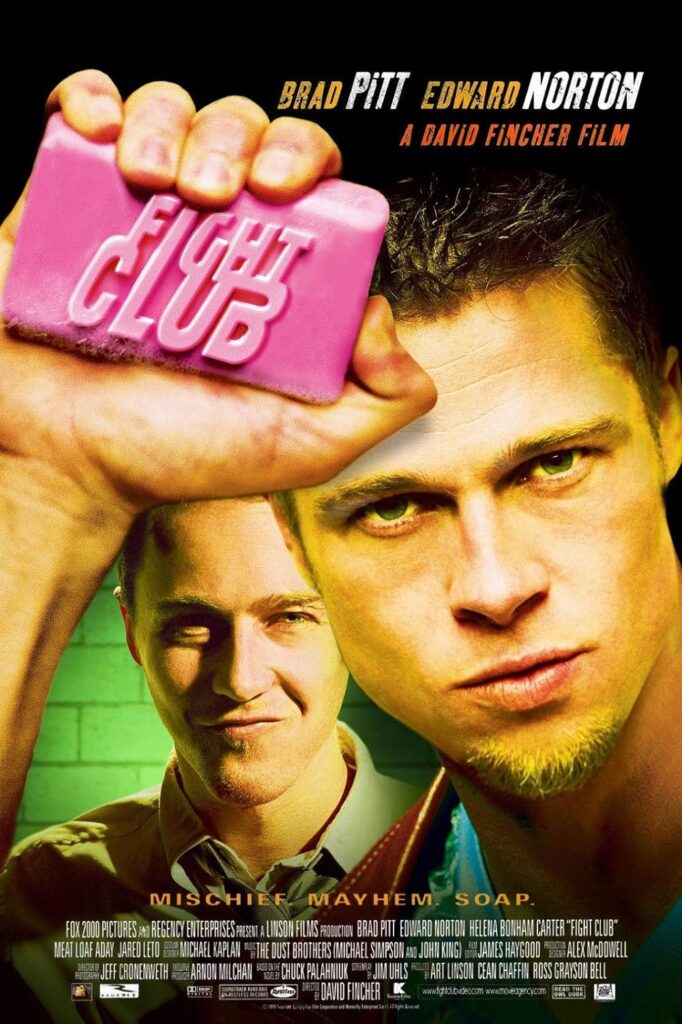
There was a stretch in the 2000s when it was as clichéd to spot a Fight Club poster hanging in an all-male dorm-room as it was to see posters for Pulp Fiction, Dark Side of the Moon, Scarface, and Che Guevara. It was also just as likely to get misread: I distinctly remember an incident in the late-2000s wherein a college-age guy (cause of course it was a guy) tried to plant a bomb at a Seattle Starbucks. When caught and questioned, his stated motive was that Fight Club was his favorite film and he wanted to start a Project Mayhem of his own.
As more than a few folks said way back when, this idiot clearly never finished watching the film, because its entire second half is a critique of the first half. Brad Pitt’s Tyler Durden spends the whole first hour making anti-corporate sabotage look not only sexy, but necessary; the entire second hour, however, centers on Ed Norton’s unnamed character racing against the clock to stop Tyler Durden, once he realizes (Heavy Spoiler to a 25 Year Old Film) Durden is just his schizophrenic alter-ego, and that his grandiose plans are starting to get real human beings killed.
Tyler Durden’s big project, you will recall, is to use his network of underground Fight Clubs to plant bombs all across Wall Street, thus destroying all debt records and liberating humanity (taking seriously the scriptural injunction to “Release thyself from bondage”[1]D&C 19:35.) Ed Norton ultimately fails to stop him, because (as Mormon and Moroni so aptly warn us), “all things must fail.” Indeed, in the final scene, Ed Norton only succeeds in killing his alter-ego by failing to shoot himself in the head.
He’s too late anyways: He and his estranged lover (a perfectly cast Helena Bonham-Carter) hold hands as they watch the New York skyline collapse in a series of fiery explosions, all while the Pixie’s “Where Is My Mind” plays into the credits[2]Needless to say, this film came out before 9/11.
Success through failure is a recurring theme throughout the film: early in the film, for example, the nascent Flight Club is almost evicted by a vindictive landlord, furious that they are using his property without permission. Brad Pitt in fact allows his hired thug to beat the living daylights out of him–which[3]If you’ll forgive the swearing ironically results in him winning the fight[4]It’s a scene that arguably presages the scene in The Dark Knight wherein Batman brutally beats up the Joker in confinement, only to ultimately lose the argument. Such, in fact, is the entire point with Durden: he is a counterfeit messiah, one who (like the real one) has born our whips and scorns, who angrily drives out the money changers, who willingly descends below all things in order to rise above all things and save us all—for the first shall be last, and the abased shall be exalted.
For that matter, Durden’s entire plan is also but a violent perversion of (or perhaps more charitably, a sincere yearning for) Christ’s entire mission on this earth: to liberate mankind from debt and bondage. Near everything about the Savior’s mortal ministry, you will also recall–from the parable of the 10,000 talents, to forgiving “seventy times seven,” to the infinite and eternal Atonement itself–is imbricated in canceling impossible debts. And if we are to be perfect in following Christ, we must forgive each other; that is, we must cancel each other’s debts–both metaphorically and literally—and be just as vigilant in driving out the money changers. In this sense, the fatal flaw in Durden’s plan wasn’t his motivation, but his execution. Only one man has the authority and the capacity to completely destroy all debts from off this earth (and purportedly, the fireworks at His Second Coming will be even more fiery than the ones in the Fight Club finale).
